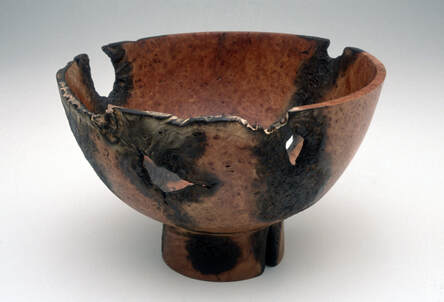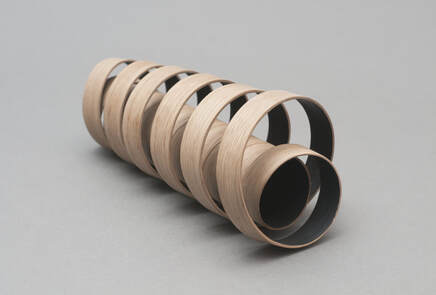Our dependence on – and love for – wood cannot be overstated. It’s integral to our very existence in a range of ways, encompassing our man-made environments as well as both utilitarian and decorative items. The organic qualities of wood, our ability to manipulate its shape, its abundance, and its renewable potential are among the reasons wood permeates our culture – including the art world.
The seventy objects comprising Explorations in Wood are a small sample of the work held in the collection of Philadelphia’s Center for Art in Wood, gathered over a forty-year period.
These works stem from a love of wood and display a rich variety of wood types. Processes are varied, too, including wood-turned vessels as well as more sculptural forms. Many celebrate the natural beauty of wood, evident in rich warm-brown tones and assorted grain patterns, typical of materials gathered around the globe.
While many of the artworks might beg to be touched due to the enticingly tactile nature of wood, it’s the design and form of each that were the basis for selection. Variety and handling also were criteria, noting that some artists, after maximizing the manipulative qualities of wood then use paint to highlight an object’s form. Others combine multiple wood types, creating forms with contrasting colors or manipulating shapes to expose varied natural and machined textures. These approaches and others highlight the diversity and unlimited potential of wood.
The Center for Art in Wood encourages an international roster of artists to not only explore the many facets of wood; the Center also continues to challenge artists to discover the inherent and dynamic possibilities of the medium.
This exhibition is made possible with support from the Henry Luce Foundation, The Center for Art in Wood, and the Michigan Council for Arts & Cultural Affairs.
To dive deeper into online resources at The Center for Art in Wood, check out The Wood Shed.
View the Explorations in Wood Virtual Opening Exhibition Reception held on April 29, 2020
Artist Spotlight
In the Artist Spotlight section we feature some of the many artists in the exhibition, and see them working and talking about their art.
Alan Stirt
War Bowl is the first bowl I have made where I do not want to express beauty of some kind. The Gulf War, which is just over as I write this, has stirred up a lot of pain and confusion for me. I made this bowl to express some of these feelings. War destroys not only the people and property, it also wounds the spirit.
Bowls can be seen as symbols of wholeness. My goal has always been to make bowls that radiate a sense of peace. This is a wounded bowl. It radiates disturbance.
– From Challenge IV: International Lathe-Turned Objects
See Al talk about his work on PBS Crossroads in the video below.
War Bowl is the first bowl I have made where I do not want to express beauty of some kind. The Gulf War, which is just over as I write this, has stirred up a lot of pain and confusion for me. I made this bowl to express some of these feelings. War destroys not only the people and property, it also wounds the spirit.
Bowls can be seen as symbols of wholeness. My goal has always been to make bowls that radiate a sense of peace. This is a wounded bowl. It radiates disturbance.
– From Challenge IV: International Lathe-Turned Objects
See Al talk about his work on PBS Crossroads in the video below.
Reed Hansuld
Reed Hansuld is a contemporary furniture maker. Approaching his craft from both traditional and modern methods each piece is meticulously hand-crafted with a keen eye for detail. His aspiration is to find innovative ways to approach classic pieces and give them a modern life without losing sight of functionality and purpose.
View the incredible furniture designs of Reed Hansuld on his website reedfurnituredesign.com
See Reed talking and working on his craft in the video below.
Zina Manesā-Burloiu
Manesā-Burloiu first encountered wood carving as a young girl in rural Romania, where she carved intricate geometrical patterns into the soft bark of tender walnut shoots. Though mere “play,” in her words, passing time this way amid the slow pace and scarcity of Communist-era village life honed her attention to detail…Mechanically inclined and with a talent for math, she left home at age thirteen to study engineering in the city. Manesā-Burloiu supported herself through high school and, later, university, by working mornings in a truck factory and studying by night. It was in the factory, in fact, where Manesā-Burloiu learned to make edged tools like the carving knives she uses today. Manesā-Burloiu began showing her work—including spoons, cups, egg holders, and candle sticks at Romanian craft fairs before expanding internationally.
Zina Manesā-Burloiu working on sculpture Peisaj
VIEW THE EXHIBITION
Click images below to view more information about each work of art.
|
|
|
|
|
|
|
|
|
|









